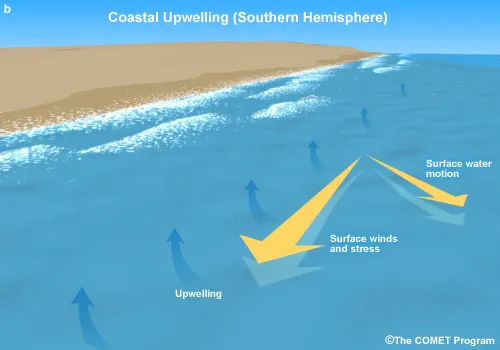Ocean Upwelling
In areas of upwelling, deep ocean water makes its way to the surface. This has an impact on marine life as well as the region's climate.
Upwelling happens commonly along coastlines. Winds blowing parallel to a coastline cause water at the ocean surface to moves at about a 90 degrees angle from the wind direction (to the right of the wind direction in the Northern Hemisphere and to the left of the wind direction in the Southern Hemisphere) because of a process called Ekman transport. In places where surface waters are moved away from a coast by this process, water rises up from deeper in the ocean to take its place.

Winds traveling north cause upwelling along the west coast of South America.
The COMET Program/UCAR
The water that is moved up to the surface is usually cold and rich in nutrients like nitrogen and phosphorus, which come from the decomposing bodies of dead sea creatures. Once at the surface, these extra nutrients are snatched up by phytoplankton, tiny photosynthesizing plants that float in the ocean water. Plankton populations often grow quickly in upwelling areas, a phenomenon called a plankton bloom. Tiny floating animals called zooplankton eat the phytoplankton and fish eat the zooplankton, making upwelling areas rich with marine life. About half the fish caught in the world comes from upwelling zones.
Upwelling also happens as a part of El Niño (ENSO) events in the Pacific Ocean off the coast of Ecuador and Peru and this has far-reaching effects on weather, changing precipitation patterns in many areas of the world.
Downwelling is the opposite of upwelling - surface waters pushing down into deeper areas of the ocean. This happens when winds cause Ekman transport to push water toward a coast and then deeper in the ocean.
© 2008 NESTA with modifications by UCAR